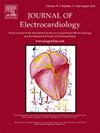Spatial QRS-T angle can indicate presence of myocardial fibrosis in pediatric and young adult patients with hypertrophic cardiomyopathy
IF 1.3
4区 医学
Q3 CARDIAC & CARDIOVASCULAR SYSTEMS
引用次数: 0
Abstract
Background
Myocardial fibrosis, expressed as late gadolinium enhancement (LGE) on cardiac magnetic resonance imaging (CMR), is an important risk factor for malignant cardiac events in hypertrophic cardiomyopathy (HCM). However, CMR is not easily available, expensive, also needing intravenous access and contrast.
Objective
To determine if derived vectorcardiographic spatial QRS-T angles, an aspect of advanced ECG (A-ECG), can indicate LGE to appropriately prioritize young HCM-patients for CMR.
Methods
Young patients (age 7–31 years) with clinical HCM (N = 19) or genotype-positive but phenotype-negative (G+ P-) results (N = 6) and nine healthy volunteers were evaluated for LGE by CMR at a single centre between 2011 and 2018. A-ECG was performed within 4 months before and 6 months after CMR and evaluated for spatial mean and peaks QRS-T angles. ECG Risk-score and frontal, two-dimensional QRS-T angle were also calculated from the 12‑lead ECG.
Results
All QRS-T angles were significantly higher in the HCM group with LGE as compared to the HCM group without LGE, and the G+ P- and Healthy groups. Only HCM-patients showed LGE (11/19). The optimal cut-offs for indicating LGE were > 50° for the spatial peaks (AUC = 0.98 [95 %CI 0.95–1.00], sensitivity 100 %, specificity 93 %; p < 0.001), >80° for the spatial mean (AUC = 0.91; p < 0.001), and > 60° for the frontal QRS-T angles (AUC = 0.85; p < 0.001), and > 2 points for an established ECG risk-score (AUC = 0.90, p < 0.001).
Conclusion
A spatial peaks QRS-T angle >50° has excellent sensitivity and specificity as a marker of myocardial fibrosis in a young patients with HCM, and can be useful for management and follow-up of such patients.
空间QRS-T角可提示小儿和青壮年肥厚性心肌病患者心肌纤维化的存在。
背景:心肌纤维化,在心脏磁共振成像(CMR)上表现为晚期钆增强(LGE),是肥厚性心肌病(HCM)恶性心脏事件的重要危险因素。然而,CMR不容易获得,价格昂贵,还需要静脉注射和对比。目的:确定作为晚期心电图(A-ECG)的一个方面,衍生矢量心电图空间QRS-T角度是否可以指示LGE适当优先考虑年轻hcm患者进行CMR。方法:2011年至2018年,在单一中心采用CMR对临床HCM (N = 19)或基因型阳性但表型阴性(G+ P-)结果(N = 6)的年轻患者(7-31岁)和9名健康志愿者进行LGE评估。分别于CMR前4个月和CMR后6个月进行A-ECG,评估QRS-T空间均值和峰值角度。同时计算12导联心电图的风险评分和额位、二维QRS-T角。结果:合并LGE的HCM组各QRS-T角度均显著高于未合并LGE的HCM组、G+ P-组和健康组。只有hcm患者出现LGE(11/19)。空间峰显示LGE的最佳截止值为bbb50°(AUC = 0.98 [95% CI 0.95-1.00]),灵敏度100%,特异性93%;空间平均值为p 80°(AUC = 0.91;正面QRS-T角度为p60°(AUC = 0.85;结论:空间峰QRS-T角>50°作为年轻HCM患者心肌纤维化的标志物具有良好的敏感性和特异性,可用于此类患者的管理和随访。
本文章由计算机程序翻译,如有差异,请以英文原文为准。
求助全文
约1分钟内获得全文
求助全文
来源期刊

Journal of electrocardiology
医学-心血管系统
CiteScore
2.70
自引率
7.70%
发文量
152
审稿时长
38 days
期刊介绍:
The Journal of Electrocardiology is devoted exclusively to clinical and experimental studies of the electrical activities of the heart. It seeks to contribute significantly to the accuracy of diagnosis and prognosis and the effective treatment, prevention, or delay of heart disease. Editorial contents include electrocardiography, vectorcardiography, arrhythmias, membrane action potential, cardiac pacing, monitoring defibrillation, instrumentation, drug effects, and computer applications.
 求助内容:
求助内容: 应助结果提醒方式:
应助结果提醒方式:


